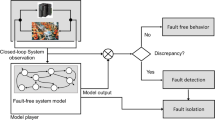Abstract
Discretely controlled continuous systems consist of continuous plants whose operation mode is switched by a feedback controller. Fault diagnosis has to use the measured switching sequence and the measured continuous movement to detect and identify faults. In order to get the diagnostic algorithm with the least possible complexity, the kind of measurement information and the granularity of the model have to be chosen in accordance with the faults to be detected. The paper presents five diagnostic methods in a uniform way, which differ with respect to the model and the measurement information used. From the hybrid model of discretely controlled continuous systems, four more abstract representations are derived, which have the form of embedded maps, semi-Markov processes, timed automata and nondeterministic automata. The validity of the diagnostic result is ensured by the claim that the models should be complete and, hence, consistent with all the input-output sequences of the discretely controlled system in the appropriate fault case. In this way a hierarchy of models and of diagnostic results is obtained. The methods are illustrated by an example.
Similar content being viewed by others
References
Alur R, Henzinger TA, Lafferriere G, Pappas GJ (2000) Discrete abstractions of hybrid systems. Proceedings of the IEEE 88:971–984
Ashley J, Holloway LE (2004) Qualitative diagnosis of condition systems. Discret Event Dyn Syst: Theory Appl 14:395–412
Blanke M, Kinnaert M, Lunze J, Staroswiecki M (2006) Diagnosis and fault-tolerant control, 2nd edn. Springer, Heidelberg
Böker G, Lunze J (2002) Stability and performance of switching Kalman filters. Int J Control 75:1269–1281
Cassandras CG, Lafortune S (1999) Introduction to discrete event systems. Kluwer, Boston
Förstner D, Lunze J (2001) Discrete-event models of quantized systems for diagnosis. Int J Control 74:690–700
Gertler J (1998) Fault detection and diagnosis in enginnering systems. Marcel Dekker, New York
Krupar J, Mögel A, Schwarz W (2004) Continuous-discrete systems – modelling and statistical analysis. Intern. Symposium on Nonlinear Theory and its Applications (NOLTA), Fukuoka, pp55–58
Lamperti G, Zanella M (2003) Diagnosis of active systems. Kluwer, Dordrecht
Lunze J (1994) Qualitative modelling of linear dynamical systems with quantised state measurements. Automatica 30(3):417–432
Lunze J (1999) A timed discrete-event abstraction of continuous-variable systems. Int J Control 72:1147–1164
Lunze J (2000) Ein Beispiel für den Entwurf schaltender Beobachter. Automatisierungstechnik 48:556–562
Lunze J (2000) Diagnosis of quantized systems based on a timed discrete-event model. IEEE Trans SMC-30:322–335
Lunze J (2006a) Ereignisdiskrete Systeme. Oldenbourg-Verlag, München
Lunze J (2006b) Discrete-event modelling and fault diagnosis of discretely controlled continuous systems. IFAC-symposium on analysis and design of hybrid systems, Alghero
Lunze J (2006c) Diagnosis of discretely controlled continuous systems. Automatisierungstechnik 54:385–395
Pappas G (2003) Bisimilar linear systems. Automatica 39:2035–2047
Patton RJ, Frank PM, Clark RN (eds) (1999) Issues of fault diagnosis for dynamical systems. Springer-Verlag, London
Polderman JW, Willems JC (1998) Introduction to mathematical systems theory: a behavioural approach. Springer
Raisch J, O’Young, S (1997) A totally ordered set of discrete abstractions for a given hybrid or continuous system. In: Antsaklis P, Kohn W, Nerode A, Sastry S (eds) Hybrid systems IV, Springer, Berlin, pp342–360
Sampath M, Sengupta R, Lafortune S, Sinnamohedeen K, Teneketzis D (1995) Diagnosability of discrete event systems. IEEE Trans AC-40:1555–1575
Sampath M, Sengupta R, Lafortune S, Sinnamohideen K, Teneketzis D (1996) Failure diagnosis using discrete event models. IEEE Trans CST-4
Schröder J (2003) Modelling, state observation and diagnosis of quantised systems. Springer, Heidelberg
Srinivasan VS, Jafari MA (1993) Fault detection/monitoring using timed Petri nets. IEEE Trans SMC-23
Supavatanakul P (2004) Modelling and diagnosis of timed discrete-event systems. Shaker, Aachen
Tse CK (2003) Complex behaviour of switching power converters. CRC Press, Boca Raton
Author information
Authors and Affiliations
Corresponding author
Additional information
Partially supported by Deutsche Forschungsgemeinschaft, grant Lu 462/21.
Rights and permissions
About this article
Cite this article
Lunze, J. Fault Diagnosis of Discretely Controlled Continuous Systems by Means of Discrete-Event Models. Discrete Event Dyn Syst 18, 181–210 (2008). https://doi.org/10.1007/s10626-007-0022-3
Received:
Accepted:
Published:
Issue Date:
DOI: https://doi.org/10.1007/s10626-007-0022-3




